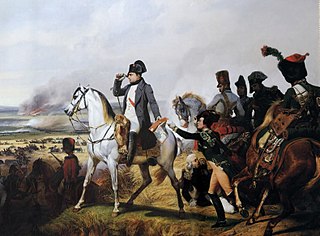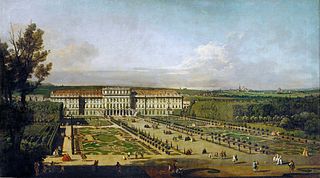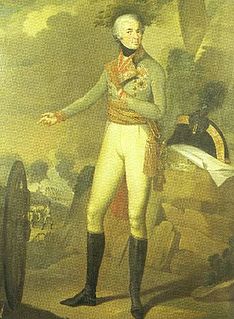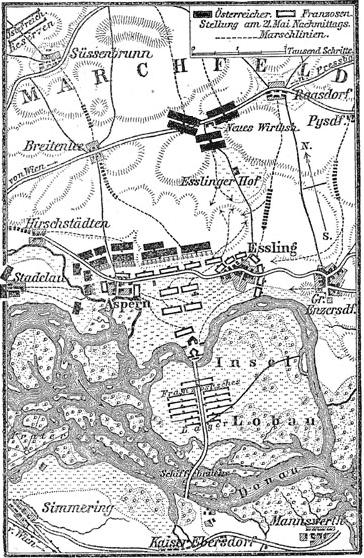
Archduke Charles Louis John Joseph Laurentius of Austria, Duke of Teschen was an Austrian field-marshal, the third son of Emperor Leopold II and his wife, Maria Luisa of Spain. He was also the younger brother of Francis II, Holy Roman Emperor. Despite being epileptic, Charles achieved respect both as a commander and as a reformer of the Austrian army. He was considered one of Napoleon's more formidable opponents.

The Battle of Wagram was a military engagement of the Napoleonic Wars that ended in a costly but decisive victory for Emperor Napoleon I's French and allied army against the Austrian army under the command of Archduke Charles of Austria-Teschen. The battle led to the breakup of the Fifth Coalition, the Austrian and British-led alliance against France.

André Masséna, 1st Duke of Rivoli, 1st Prince of Essling was a French military commander during the French Revolutionary Wars and the Napoleonic Wars. He was one of the original eighteen Marshals of the Empire created by Napoleon I, with the nickname l'Enfant chéri de la Victoire.

The Lobau is a Vienna floodplain on the northern side of the Danube in Donaustadt and partly in Großenzersdorf, Lower Austria. It has been part of the Danube-Auen National Park since 1996 and has been a protected area since 1978. It is used as a recreational area and is known as a site of nudism. There is also an oil harbour, and the Austrian Army used the Lobau as a training ground. In addition to the water coming from the Alps through the Wiener Hochquellenwasserleitung, the Lobau is a source of groundwater for Vienna.

Johann I Joseph was Prince of Liechtenstein between 1805 and 1806 and again from 1814 until 1836. He was the last Liechtenstein prince to rule under the Holy Roman Empire between 1805 and 1806 and as regent of Liechtenstein from 1806 until 1814. He was the fourth son of Franz Joseph I, Prince of Liechtenstein.

In the Battle of Aspern-Essling, Napoleon attempted a forced crossing of the Danube near Vienna, but the French and their allies were driven back by the Austrians under Archduke Charles. The battle was the first time Napoleon had been personally defeated in over a decade, but Aspern would be a sign of numerous military defeats and blunders that would soon hinder Napoleon. However, Archduke Charles failed to secure a decisive victory as Napoleon was able to successfully withdraw most of his forces.

The War of the Fifth Coalition was fought in 1809 by a coalition of the Austrian Empire and the United Kingdom, Portugal and Spain against Napoleon's French Empire and its German allies, chiefly Bavaria. Erstwhile coalition members Prussia and Russia did not participate. Major engagements between France and Austria unfolded over much of Central Europe from April to July, with very high casualty rates for both sides. Britain, already involved on the European continent in the ongoing Peninsular War, sought to further assist the Austrian intervention by launching the Walcheren Campaign, although this effort had little impact on the outcome of the conflict.

The Treaty of Schönbrunn, sometimes known as the Peace of Schönbrunn or Treaty of Vienna, was signed between France and Austria at Schönbrunn Palace near Vienna on 14 October 1809. The treaty ended the Fifth Coalition during the Napoleonic Wars, after Austria had been defeated at the decisive Battle of Wagram on 5-6 July.

Donaustadt is the 22nd district of Vienna, Austria . Donaustadt is the eastern district of Vienna.

Aspern is part of Donaustadt, the 22nd district of Vienna.

Louis Aloysius, Prince of Hohenlohe-Waldenburg-Bartenstein was a German prince and Marshal of France. He commanded a division of Austrian soldiers in the 1809 and 1814 campaigns during the Napoleonic Wars.

Johann Baron von Hiller was an Austrian general during the French Revolutionary Wars and the Napoleonic Wars. He held an important command during the 1809 campaign against France, playing a prominent role at the Battle of Aspern-Essling.
Events from the year 1809 in France.

Johann von Klenau, also called Johann Graf von Klenau, Freiherr von Janowitz, was a field marshal in the Habsburg army. Klenau, the son of a Bohemian noble, joined the Habsburg military as a teenager and fought in the War of Bavarian Succession against Prussia, Austria's wars with the Ottoman Empire, the French Revolutionary Wars, and the Napoleonic Wars, in which he commanded a corps in several important battles.

Friedrich Franz Xaver Prince of Hohenzollern-Hechingen was an Austrian general. He joined the Austrian military and fought against the Kingdom of Prussia, Ottoman Turkey, and the First French Republic. He was promoted to the rank of general officer during the French Revolutionary Wars. During the Napoleonic Wars, he led a division in 1805 and an army corps in 1809. He was Proprietor (Inhaber) of an Austrian cavalry regiment from 1802 to 1844.

The Retreat is a historic novel by the French author Patrick Rambaud that was first published in 2000. The English translation by Will Hobson appeared in 2004.
Joseph-Armand Ritter von Nordmann, was a French officer in the French Royal Army. He transferred his allegiance to Habsburg Austria during the French Revolution, like other French émigrés. In Austrian service he fought capably against his former country during the French Revolutionary Wars and the Napoleonic Wars.

Nicolas-Marie Songis des Courbons, Count of the Empire,, was a French artillery commander during the French Revolutionary Wars, who rose to the rank of General of Division in 1800 and served as commander of the Grande Armée artillery between 1805 and 1809, during the Napoleonic Wars.
The Napoleonic Wars were a defining event of the early 19th century, and inspired many works of fiction, from then until the present day.

Johann Freiherr von O'Brien, Earl of Thomond, was an Austrian Major General with Irish ancestry, most noted for leading an action in Jedlesee, 1809, near Vienna, against a superior force of Napoleon's troops in preparation for their defeat by Archduke Charles in the Battle of Aspern.

















